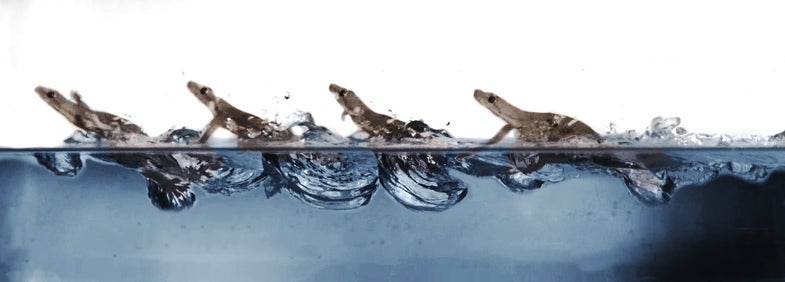It turns out geckos can run on water—and this adorable video shows how
These little lizards combined evolutionary tactics to come up with their own unique way of running.

Geckos can run straight up a wall, but it’s their ability to run across water that makes them truly weird. Multiple animals can stick on vertical surfaces, after all. And yes, some can run on top of water—but not many that are as big as geckos. These little lizards have to combine three separate strategies into one unified motion that scientists think might be unique in the animal kingdom.
A group of biologists from universities around the world discovered the phenomenon when one of them happened to catch video evidence while on vacation in Singapore. It was such a surprise that geckos could run on the surface of water that they decided to study it in more depth. They published their results in the journal Current Biology, and to really understand why they’re so unusual we have to geek out a little.
If you—a hypothetical species in the process of evolving—want to walk on water, there are two main tactics you can take. One is to be so small that you can use the high surface tension of water to float on the top. This is how water skitters and spiders do it. If you look closely at a floating insect you can see that their little legs produce tiny depressions in the water’s surface—that’s the force of their body pressing down on the water, but not enough to break the surface tension.
The other tactic is to be large and muscular enough to paddle so hard you can stay above the surface. Swans do this on takeoff to get themselves off the water, and basilisk lizards do it to run upright across ponds. Both animals have enough power behind each stroke or slap (yes, that is the technical term) to push themselves out of the water, effectively staying atop it instead of swimming.
Geckos aren’t big enough to produce that force, but they’re also not small enough to float using only surface tension. So what’s a gecko to do? Well, both. They also incorporate a tactic usually used in swimming: waggling. Alligators can propel themselves alarmingly quickly by waving their powerful bodies and tails back and forth rapidly, and it turns out geckos can do the same.
To figure all this out, the researchers had to head back to the lab to capture high speed video of geckos implementing their weird hybrid swimming-running technique.
You can see pretty easily how they’re smacking the water with their feet. That’s actually creating air cavities that help buoy the geckos along in addition to creating an upward force to keep their heads above the surface. You can also see how they’re propelling themselves forward with their tails. What you can’t really see are the third and fourth factors. Let’s start with the influence of surface tension. Small animals use surface tension to stay afloat, but you can’t necessarily see that effect when a gecko is wildly flailing its legs. So the researchers stuck the geckos in soapy water.
Surface tension normally works because water molecules have a greater attraction to each other than they do to the air, so they’ll tend to stick together until a large enough force breaks them apart. Soap prevents that from happening because it has one end that attracts polar water molecules and one end that attracts nonpolar molecules—that means it’s equally attracted to everything around it, thus reducing the surface tension.
When researchers stuck geckos in soapy water, the lizards could only move at 58 percent of their normal speed, indicating that surface tension normally helps them.
The final factor is their skin, which is super hydrophobic and thus repels water. Hydrophobic surfaces can skim across the surface more easily, a bit like hydroplaning, because there’s so little friction between the water and the hydrophobic substance. Without that friction pulling them back, geckos can more easily get up to speed and slide across the water.
All these individual tactics combine to allow them to run on water faster than they could possibly swim in it, which has likely helped them escape thousands of years’ worth of predators trying to snap them up. It just so happens that geckos found this weird niche. But hey—if it ain’t broke, don’t fix it.